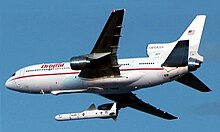SNOE
| SNOE (Explorer 72) | |
|---|---|

|
|
| Type: | Research satellite |
| Country: |
|
| Operator: |
Boston University |
| COSPAR-ID : | 1998-012A |
| Mission dates | |
| Dimensions: | 115 kg |
| Begin: | February 26, 1998, 07:07 UTC |
| Starting place: | VAFB , L-1011 , WADZ |
| Launcher: | Pegasus-XL HAPS F20 |
| Status: | Burned up on December 13, 2003 |
| Orbit data | |
| Rotation time : | 95.80 min |
| Orbit inclination : | 97.97 ° |
| Apogee height : | 535 km |
| Perigee height : | 580 km |
SNOE ( Student Nitric Oxide Explorer ), and Explorer 72 , was a small research satellite of NASA will study the evolution of nitric oxide in the earth's atmosphere .
The scientific tasks of the SNOE satellite were a detailed study of the variations in the nitrogen monoxide (NO) content of the terrestrial thermosphere . The proportion of nitrogen monoxide in the high atmosphere is small, but it has a strong influence on the ionic composition of the ionosphere . SNOE investigated in detail how fluctuations in solar soft X-rays cause changes in the NO content of the lower thermosphere and how aurora activity produces nitric oxide in the polar regions.
background
SNOE was a mission under NASA's Explorer program . Within the program, SNOE was selected as the first of three missions of the new Student Explorer Demonstration Initiative (STEDI). This initiative made it possible to realize small research satellites under the leadership of universities. A team from the Laboratory for Atmospheric and Space Physics (LASP) at the University of Colorado at Boulder was in charge of the SNOE mission .
construction
SNOE consisted of a satellite structure in the form of a hexagonal prism, which was built just like the instruments at the LASP. The satellite was spin stabilized , with the axis of rotation perpendicular to the orbit plane. On the outer surface of the satellite body there were solar cells for power supply, which was buffered by a battery for the times in the earth's shadow. The instruments were arranged perpendicular to the axis of rotation so that they scanned the earth's atmosphere under the flight path during the rotation . The satellite did not have its own propulsion system.
Instruments
- The task of the Ultraviolet Specrometer (UVS) was to measure the density of nitrogen monoxide in the earth's atmosphere at altitudes between 100 and 200 km by recording the absorption band in the ultraviolet part of the spectrum. It consisted of a telescope, an Ebert-Fastie spectrometer and two photocells as a detector.
- The Auroral Photometer (AP) was a two-channel broadband instrument for determining the energy released into the upper atmosphere by energetic electrons of the aurora.
- The Solar X-ray Photometer (SXP) consisted of five individual photometers that measure the solar X-ray and EUV radiation at wavelengths between 2 and 35 nm .
- GPS receiver : There was also a GPS receiver on board, which made it possible to determine the exact position and attitude of the satellite.
Mission history
On February 26, 1998, an airplane-launched Pegasus XL rocket from Vandenberg Air Force Base successfully put SNOE into polar earth orbit together with the experimental communications satellite BATSAT .
SNOE remained in operation for its entire five-year, 290-day lifespan and provided data until re-entry. The re-entry took place on December 13, 2003 after 32,248 orbits around the earth.
Web links
- SNOE website at the LASP
- SNOE in the NSSDCA Master Catalog (English)
- SNOE (STEDI 1) on Gunter's Space Page
Individual evidence
- ↑ a b c d SNOE (Orbit) in the NSSDCA Master Catalog (English)
- ↑ a b c d e SNOE in the NSSDCA Master Catalog (English)
- ↑ NASA: Student Explorer Demonstration Initiative ( Memento from April 19, 2003 in the Internet Archive )
- ^ LASP: Spacecraft
- ↑ a b c d LASP: Instruments

